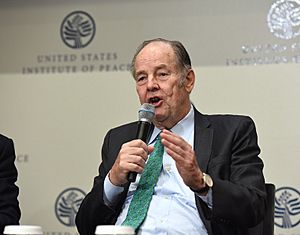Thomas Kean facts for kids
Quick facts for kids
Thomas Kean
|
|
|---|---|
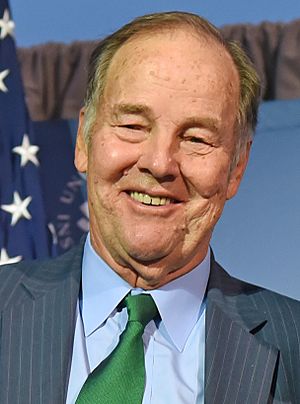
Kean in 2018
|
|
| President of the Carnegie Corporation of New York | |
| Acting April 15, 2021 – January 2023 Served with Janet L. Robinson |
|
| Preceded by | Vartan Gregorian |
| Succeeded by | Louise Richardson |
| Chair of the 9/11 Commission | |
| In office December 15, 2002 – August 21, 2004 |
|
| President | George W. Bush |
| Deputy | Lee Hamilton |
| Preceded by | Henry Kissinger |
| Succeeded by | Position abolished |
| 10th President of Drew University | |
| In office 1990–2005 |
|
| Preceded by | Paul Hardin III |
| Succeeded by | Robert Weisbuch |
| 48th Governor of New Jersey | |
| In office January 19, 1982 – January 16, 1990 |
|
| Preceded by | Brendan Byrne |
| Succeeded by | James Florio |
| Speaker of the New Jersey General Assembly | |
| In office 1972–1973 |
|
| Preceded by | Barry T. Parker |
| Succeeded by | S. Howard Woodson |
| Member of the New Jersey General Assembly | |
| In office 1968 – 1978 Served with Philip Kaltenbacher (1967–1974) Jane Burgio (1974–1977) |
|
| Preceded by | Proportional representation |
| Succeeded by | Frederic Remington |
| Constituency | 11-F (1968–1972) 11-E (1972–1974) 25th (1974–1978) |
| Personal details | |
| Born |
Thomas Howard Kean
April 21, 1935 New York City, New York, U.S. |
| Political party | Republican |
| Spouse |
Deborah Bye
(m. 1967; died 2020) |
| Children | 3, including Tom Jr. |
| Education | Princeton University (BA) Columbia University (MA) |
Thomas Howard Kean (born April 21, 1935) is an American politician and educator from New Jersey. He is a member of the Republican Party. Kean served as the 48th Governor of New Jersey for two terms, from 1982 to 1990.
His family has a long history in politics. His father, Robert Kean, was a member of the U.S. House of Representatives. His grandfather, Hamilton Fish Kean, was a U.S. senator. After college, Thomas Kean taught history and earned a master's degree. He was part of the New Jersey General Assembly from 1968 to 1978. He even served as the Speaker of the Assembly from 1972 to 1973.
In 1981, Kean was elected governor of New Jersey and was re-elected in 1985. He was known as a popular governor who helped promote tourism in New Jersey. After being governor, Kean became the president of Drew University from 1990 to 2005.
After the September 11 attacks, President George W. Bush chose Kean to lead the 9/11 Commission. This group investigated the attacks and suggested ways to prevent future ones. On July 22, 2004, Kean and the commission released their important findings in the 9/11 Commission Report. Thomas Kean is also the father of U.S. Representative Thomas Kean Jr..
Contents
Early Life and Education
Kean was born in New York City. His family had a long history in New Jersey politics. His mother was Elizabeth Stuyvesant Howard. His father, Robert Kean, was a U.S. representative from 1939 to 1959. Kean's grandfather, Hamilton Fish Kean, and great-uncle, John Kean, both served as U.S. senators from New Jersey. He is also related to William Livingston, who was the first governor of New Jersey.
Kean went to several schools, including The Potomac School and St. Albans School. At age eleven, he enrolled at St. Mark's School in Massachusetts. This was the same school his father and older brothers attended.
After St. Mark's, Kean went to Princeton University. He studied history and wrote a paper about Julian Ursyn Niemcewicz, a Polish patriot. He graduated from Princeton in 1957. After working on his father's political campaign, Kean taught history for three years. He then earned his master's degree in history from Teachers College at Columbia University.
Political Career in New Jersey
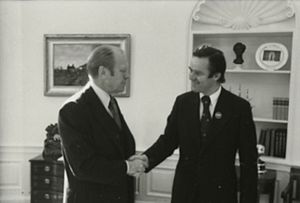
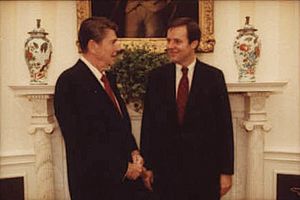
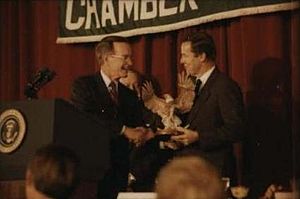
In 1967, Kean was elected to the New Jersey General Assembly. He was a moderate Republican. In 1972, he became the Speaker of the Assembly. This was a big role where he led the discussions and work of the Assembly. In 1973, he briefly served as acting New Jersey governor.
In 1974, Kean ran for Congress but did not win the primary election. During the 1976 presidential campaign, Kean managed Gerald Ford's campaign in New Jersey.
Running for Governor
In 1977, Kean first ran for the Republican nomination for governor but lost. After that, Governor Brendan Byrne appointed Kean to the board of the New Jersey Turnpike Authority. Kean also worked as a political commentator on New Jersey public television.
Four years later, in 1981, Kean ran for governor again. He promised to create jobs, clean up toxic waste sites, and reduce crime. This time, he won the support of former U.S. President Gerald Ford.
In the 1981 election, Kean won against Democratic Representative Jim Florio. It was a very close election, with Kean winning by only 1,797 votes.
Re-election and Time as Governor
In 1985, Kean was re-elected governor by a huge margin. He defeated Peter Shapiro with 70% of the votes. This was the largest victory margin ever in a New Jersey gubernatorial election.
As governor, Kean focused on education. He served on the President's Education Policy Advisory Committee. He also led the Education Commission of the States.
Kean became nationally known for promoting New Jersey tourism. He appeared in TV commercials with celebrities like Brooke Shields and Bill Cosby. In these ads, he said the state's tourism motto: "New Jersey and You: Perfect Together." This campaign helped make New Jersey a popular vacation spot.
In 1988, Kean gave an important speech at the 1988 Republican National Convention. He also wrote a book called The Politics of Inclusion.
Kean helped create and fund the New Jersey Performing Arts Center in Newark. This is one of the largest performing arts centers in the country. He believed it would help improve Newark and the whole state.
He was known for working with both political parties. He supported removing New Jersey's public funds from South Africa during apartheid. He also supported the statewide holiday for Martin Luther King Jr. Day.
In January 1990, Kean's time as governor ended. Governors in New Jersey can only serve two terms in a row.
Governor's Impact
When Kean left office in 1990, he was one of the most popular political figures in New Jersey. Many important New Jersey leaders in the 1990s and 2000s started their careers working for Kean.
Rutgers University–New Brunswick's Center on the American Governor created the Thomas H. Kean Archive. This archive keeps records of his time as governor.
President of Drew University
In 1990, after his time as governor, Kean became the President of Drew University. This is a liberal arts university in Madison, New Jersey. During his presidency, more students applied to Drew. The university's money (endowment) almost tripled. More than $60 million was spent on new buildings and renovating old ones.
Kean often ate lunch with students and watched their sporting events. He served as Drew's president until 2005. He also taught a special political science class at the university.
National Leadership Roles
After his time as governor, Kean started sharing his thoughts on foreign policy. He supported free trade and continued U.S. aid to groups fighting for democracy.
Kean was appointed to several important foreign policy groups. These included the National Endowment for Democracy (NED). He also served as co-chair of the National Security Preparedness Group (NSPG).
Other Important Work
Kean has led many important organizations. He was chairman of The Robert Wood Johnson Foundation, which is a large health charity. He also chaired the Carnegie Corporation of New York. He served on the boards of several large companies like Aramark and UnitedHealth Group.
From 1995 to 2018, Kean wrote a weekly column for The Star-Ledger newspaper. He wrote it with former New Jersey Governor Brendan Byrne. The column was called "Kean-Byrne Dialogue" and discussed current issues.
Kean is also an advisor for Alpha Phi Omega, a national service group. He is a partner in Quad Partners, a company that invests in education.
Chair of the 9/11 Commission
After the September 11 terrorist attacks in 2001, there was a strong demand for an independent group to investigate. This group would find out why the attacks were not stopped and how to prevent future ones. This group became known as the 9/11 Commission. It was considered one of the most important U.S. government commissions ever.
Kean was chosen to lead this commission. His appointment and the commission's work gained a lot of attention worldwide.
Commission's Findings
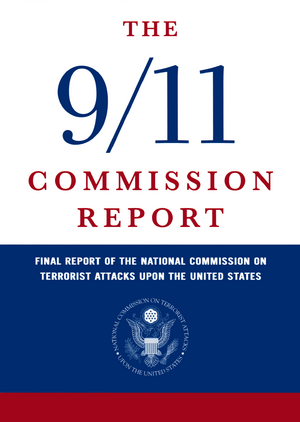
In December 2003, as the investigation was finishing, Kean said the September 11 attacks could have been prevented. He stated that the government should have acted sooner against al-Qaeda.
On July 22, 2004, the Commission released its final report, the 9/11 Commission Report. This 585-page report concluded that the CIA and the FBI did not do enough to predict or prevent the attacks. The report stated that the attacks were preventable.
Later Work on 9/11
On August 15, 2006, Kean and the Commission's Vice Chair, Lee H. Hamilton, released a book. It was called Without Precedent: The Inside Story of the 9/11 Commission. In the book, they wrote that the commission was frustrated by incorrect information from some government bodies.
Kean also worked as a consultant for the ABC miniseries The Path to 9/11. This series aired in September 2006. It showed events leading up to the attacks.
The commission met again in Washington, D.C., on July 22, 2014. This was for the tenth anniversary of their report. They checked how well the government was doing in fighting terrorism and following their recommendations.
Awards and Recognition
Kean has received over 30 honorary degrees and many awards. These awards come from environmental and educational groups. Some of his awards include:
- The Four Freedoms Award
- NAACP's "Man of the Year" award
- The Senator John Heinz Award for Public Service
- The National Wildlife Federation's "Conservation Achievement Award"
- The American Institute for Public Service's Jefferson Award for Public Service
In 2009, a ferry was named the Governor Thomas Kean in his honor. On January 15, 2009, this ferry helped rescue people when US Airways Flight 1549 made an emergency landing on the Hudson River.
In 2013, Kean was added to the New Jersey Hall of Fame.
Personal Life
Thomas Kean met his wife, Deborah Bye, in Manhattan. They married on June 3, 1967. They had three children: a daughter named Alexandra, and twin sons, Tom Jr. and Reed.
Kean moved to Livingston, New Jersey in 1967. As of 2015, he lived in Bedminster, New Jersey. Deborah Kean passed away on April 24, 2020, at the age of 76. They had been married for 53 years.


